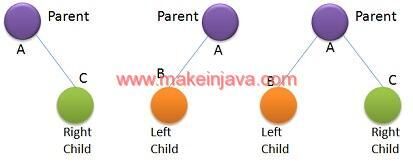- Given a binary tree, convert a tree into mirror binary tree using depth first search or recursive algorithm.
- Create symmetric (or mirror image) binary tree using post order traversal..

Examples – Convert binary tree to mirror or symmetric tree (recursive)
Example 1: Mirror binary tree having right child in java
- Given a binary tree having left child node only (refer Fig 2).
- Node C is left child of Node A.
- Mirror binary tree, will have right child node only.
- Node C become right child of Node A.
Example 2: Symmetric binary tree having left child (recursive)
- Given a binary tree having right child node only (refer Fig 3).
- Node C is right child of Node A.
- Symmetric binary tree, will have left child node only.
- Node C become left child of Node A.
Example 3: image binary tree having left & right child (recursive).
- Given a binary tree having left & right child node (refer Fig 4).
- Node B is left child of Node A.
- Node C is right child of Node A.
- Mirror binary tree, will have left & right nodes swapped.
- Node B becomes right child of Node A.
- Node C becomes left child of Node A.
Algorithm: convert binary tree into mirror binary tree in java
- Perform post order traversal of given binary tree (Root node A).
- Traverse left subtree i.e. Node B
- Traverse left subtree i.e. Node D
- Swap left (null) & right child (null) node.
- Swap will have no impact & return from here.
- Traverse right subtree i.e Node E
- Swap child nodes & return
- Swap left child (D) & right child (E)
- Traverse left subtree i.e. Node D
- Traverse right subtree i.e. Node C
- Traverse left subtree left i.e. Node F
- Swap child nodes & return
- Post order traversal for right child G
- Swap child nodes & return
- Swap left child (F) and right child (G)
- Traverse left subtree left i.e. Node F
- Swap left (B) and right child (C)
- We have successfully generated the mirror binary tree.
Time complexity of algorithm will be O(n).
Program – convert binary tree to mirror or image or symmetric tree in java
1.) MirrorTree Class:
- MirrorTree class is responsible for converting binary tree to symmetric binary tree.
- Traverse the binary trees using depth first search recursive algorithm.
package org.learn.Question;
import java.util.LinkedList;
import java.util.Queue;
public class MirrorTree {
public static void mirrorTree(Node root) {
if(null == root) {
return;
}
mirrorTree(root.left);
mirrorTree(root.right);
Node swapNode = root.left;
root.left = root.right;
root.right = swapNode;
return;
}
public static void printTree(Node root) {
if (root == null) {
System.out.println("Tree is empty");
return ;
}
Queue queue = new LinkedList();
queue.offer(root);
while (!queue.isEmpty()) {
Node node = queue.poll();
System.out.printf(" %d",node.data);
if (node.left != null) {
queue.offer(node.left);
}
if (node.right != null) {
queue.offer(node.right);
}
}
System.out.println("");
return;
}
}
2.) Node Class:
- Node class is representing the nodes of a binary tree.
package org.learn.Question;
public class Node {
public int data;
public Node left;
public Node right;
public Node(int num) {
this.data = num;
this.left = null;
this.right = null;
}
public Node() {
this.left = null;
this.right = null;
}
public static Node createNode(int number) {
return new Node(number);
}
}
3.) App Class:
- We are creating a binary tree in main method.
- We are calling method of MirrorTree class to convert binary tree into mirror binary tree.
- We will print the binary trees using level order traversal.
package org.learn.Client;
import org.learn.Question.MirrorTree;
import org.learn.Question.Node;
public class App {
public static void main(String[] args) {
// root level 0
Node A = Node.createNode(55);
// Level 1
Node B = Node.createNode(50);
Node C = Node.createNode(40);
// Level 2
Node D = Node.createNode(25);
Node E = Node.createNode(80);
Node F = Node.createNode(45);
Node G = Node.createNode(90);
// connect Level 0 and 1
A.left = B;
A.right = C;
// connect level 1 and level 2
B.left = D;
B.right = E;
C.left = F;
C.right = G;
System.out.println("Binary Tree");
MirrorTree.printTree(A);
MirrorTree.mirrorTree(A);
System.out.println("Mirror Binary Tree");
MirrorTree.printTree(A);
}
}
Output – mirror or Symmetric binary tree in java (Fig 5):
Binary Tree : 55 50 40 25 80 45 90 Mirror Binary Tree : 55 40 50 90 45 80 25
Download code – convert mirror image of binary tree (recursive)
